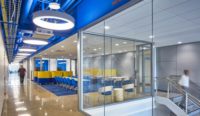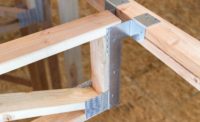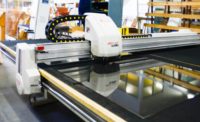Blending the visual line between fire-rated and non-rated curtain walls has long proved challenging for architects. For years, fire-rated frames were bulky, wraparound affairs. While functional at blocking heat and keeping people safe, few offerings closely replicated the sleek frame profiles heralded in modern curtain wall design. This impeded design professionals’ ability to create visual harmony with non-rated systems.
In exterior fire-rated glass curtain walls, this design trade-off grew even more pronounced. To meet deflection limits and window load criteria while supporting the added weight of fire-rated glass, it was often necessary to further increase the frame profile size. This led to jarring visual transitions at rated and non-rated junctions—problematic for these highly visible locations.
For Fred Lavery, owner of an Audi dealership in the Central Business District of Birmingham, MI, this was exactly the tradeoff he was looking to sidestep. To design a dealership with a bold, open outer look that adhered to Audi standards and ample windows to provide pedestrians with clear views of the cars from multiple vantage points, it was essential to visually align the dealership’s rated and non-rated exterior curtain walls. To achieve this desirable outcome while adhering to local building codes, design professionals turned to an advanced steel fire-rated curtain wall system.
Meeting building codes and brand standards with fire-rated materials
With its iconic four ring logo on the grill and sleek design, consumers know an Audi on the road when they see one. Thanks to the Audi Terminal Concept, the same is now being said of their dealerships. The company’s unified design standard enables dealerships to embody the style of Audi vehicles, resulting in buildings that are as identifiable as the cars inside.
“Audi regulations require dealerships to resemble each other as closely as possible,” explained Lavery. “This meant we needed a large wall of extremely clear glass to match the other buildings and make it easy for people driving by to see the cars inside.”
To create the transparent exterior, HED Design was keen on using a series of expansive curtain walls to reflect the company’s spatially open style. The large spans of glazing would also draw attention to the showroom, which sits on one of the most heavily trafficked streets in the district. To move forward with the approach, it was first necessary to adhere to several local building codes.
Turning to transparent solutions
The Audi dealership is located in a zone that allows zero space between the building and sidewalk. Due to the narrow property line setback, a building could be constructed near the glass opening on the north side of the property. To prevent a fire from spreading between any future adjacent structures, local building codes required the use of fire-rated materials along the dealership’s north side.
Inspired to think beyond traditional methods, Lavery and the design team turned to fire-rated glass to preserve the building’s open exterior. It was the only material that could provide lot-line protection and satisfy local building codes without sacrificing transparency and visibility.
With a material in mind, the firm’s focus shifted to identifying a product that would align with Audi’s upscale aesthetic. “For the exterior to look normal in the worldwide design delegated by Audi, we needed an unnoticeable difference between the fire-rated and non-rated glazing,” explained Lavery. “The glass needed to be as beautiful as traditional offerings, without distortion and with a true clear color.”
Overcoming design challenges and creating a close visual match
In addition to requiring a visual match for color and clarity, HED Design wanted large pieces of fire-rated glass in various shapes and sizes to maintain the desired curtain wall aesthetic. This led to the need for a stronger, more durable framing system, rather than a typical aluminum one, to support the oversized fire-rated glass lites. Equally crucial to the design was a fire-rated framing system with sleek, narrow profiles to ensure visual compatibility with the other non-rated curtain wall systems.
HED Design deftly navigated the project’s challenges, finding an all-encompassing solution with a new-generation steel fire-rated glass curtain wall system. It is rated for two hours, defends against the transfer of radiant and conductive heat and is tested for the rigors of exterior use. This includes supplemental loads, such as wind loads, as well as exposure to water.
To achieve the design intent without sacrificing performance, the selected curtain wall system uses inherently heat-resistant carbon steel. Due to its material makeup, the framing system does not require thermal barriers within its core to protect against heat transfer. The frames are strong enough to meet applied loads yet still slender, with clean, sharp edges and crisp profiles. To preserve its integrity, the system employs a continuous gasket system that isolates the steel framing member from any water exposure inside the glazing cavity. The outcome is a two-lines-of-defense strategy.
To create the desired glass aesthetic, the selected curtain wall system uses a fire- and impact safety-rated glazing material comprised of layers of nearly colorless low-iron float glass with high light transmission. The glass provides nearly the same level of visual clarity and color as ordinary float glass, while still meeting stringent fire- and life-safety criteria. In alignment with the design team’s needs, it is available in large sizes.
A dealership worth noticing
In application, the system’s slender frame profiles and crisp edges blend well with the adjacent non-rated curtain wall systems. Angled pieces and mitered corners even allowed the design team to emulate the company’s trademark curved curtain walls. Additionally, due to steel’s impressive strength, the frames were able to support the added weight of fire-rated glazing without a significant increase in profile size. In the case of Lavery’s dealership, they support 21-foot free spans.
“The glazing looks like regular glass, but it feels different. You can test the strength by simply knocking on it. Otherwise, you wouldn’t know the difference,” concluded Lavery.




